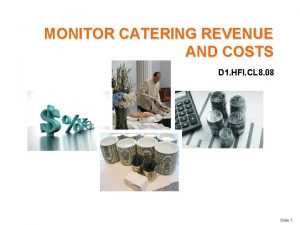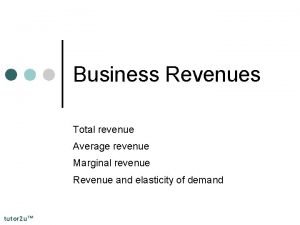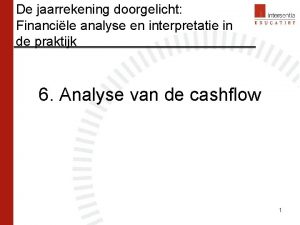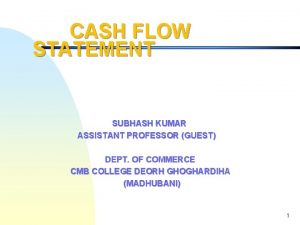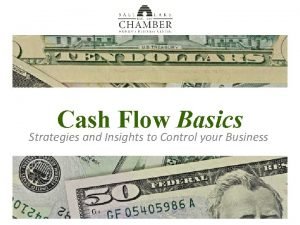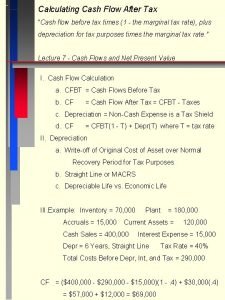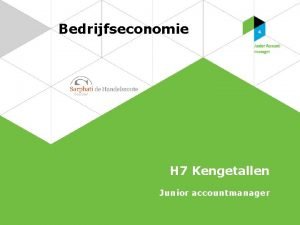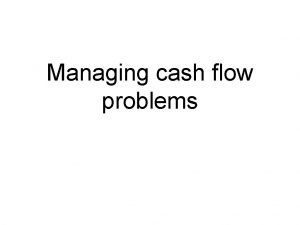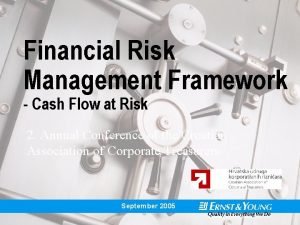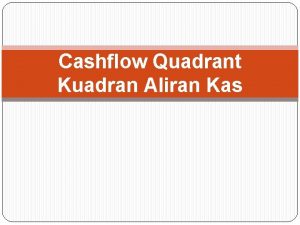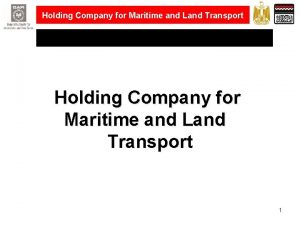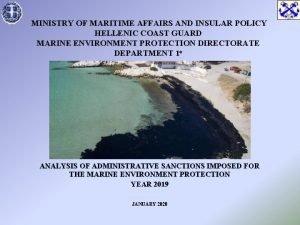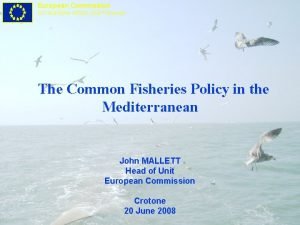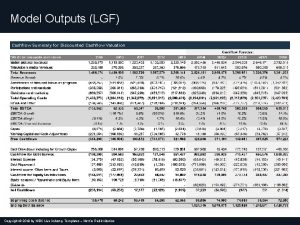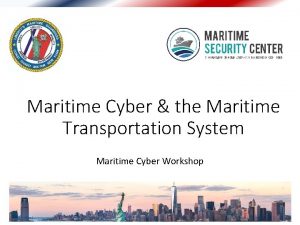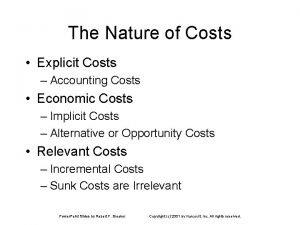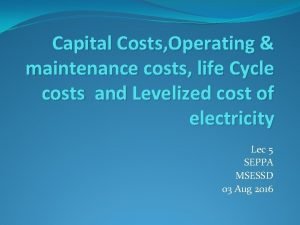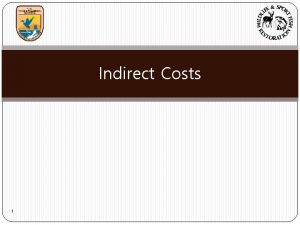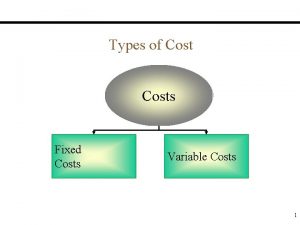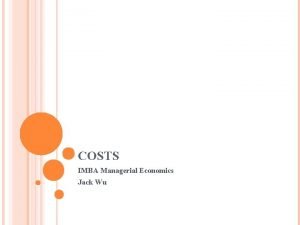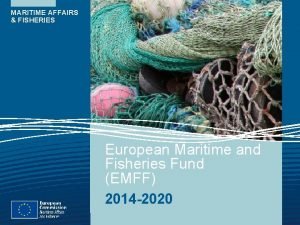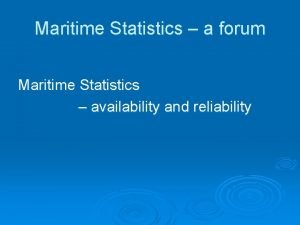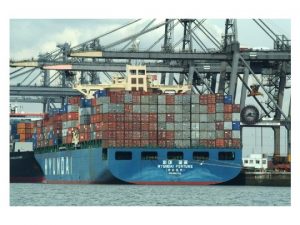Costs Revenue and Cashflow Maritime Economics Cashflow the













































- Slides: 45

Costs, Revenue and Cashflow Maritime Economics

Cashflow & the art of Survival �Every company faces the challenge of navigating its way through the succession of booms, recessions and depressions which characterize the shipping market. �During prosperous periods, it must meet the challenge of investing wisely for future growth. �In recessions the challenge is to keep control of the business when the market is trying to force surplus capacity out of the system by squeezing cashflow and take advantage of the opportunities. �What sorts out the winners from the losers is financial performance.

Crucial factors �Economies of scale �Operational planning (increased productivity) �Reducing backhauls �Minimize time off hire �Deadweight tonnage utilization �Cutting cargo-handling time IMPORTANT: Choice of ship, ship operation, financial strategy

Financial performance & investment strategy �The three key variables with which shipowners can survive in the shipping market are: �The revenue received from chartering/operating the ship �The cost of running the ship �The method of financing the business


Financial performance & investment strategy �The way shipping companies manage these cost & revenue variables significantly influence the financial performance of the business: �The choice of ship influences the running cost: Day to day costs are higher for old ships with ageing machinery requiring constant maintenance. �Running a successful shipping operation is not just a matter of costs: � it also involves squeezing as much revenue as possible out of the ship. Revenue may be steady on a long-time charter or irregular on the spot market. � It may be increased by careful management, clever chartering and flexible ship design to minimize time ballast and ensure that the vessel is earning revenue for a high proportion of its time at sea.

Financial performance & investment strategy �Financing strategy is crucial: if the vessel is financed with debt, the company is committed to a schedule of capital repayments, regardless of market conditions. If the ship is financed from the owners’ cash revenues or outside equity finance there are no fixed payments to capital. �In practice if a shipping company has only limited equity capital, the choice is often between an old vessel with high running costs but no debt or a new vessel with low running costs and a mortgage.

The classification of costs �Three broad categories 1. Vessel’s cost � Fuel consumption, number of crew, physical condition 2. The cost of bought in items � Bunkers, consumables, crew wages, ship repairs, interest rates 3. Management efficiency � Administrative overheads, operational efficiency

The classification of costs �Operating Costs, which constitute the expenses involved in the day to day running of the ship- essentially those costs such as crew, stores and maintenance. �Periodic maintenance costs are incurred when the ship is dry-docked for major repairs, usually at the time of its special survey. �Voyage costs are variable costs associated with a specific voyage and include items as fuel, port charges and canal dues. �Capital costs depend on the way the ship has been financed. �Cargo handling costs represent the expense of loading, stowing and discharging cargo (especially in liner trades).

Ship age and the supply price of freight

Ship age and the supply price of freight �In market recessions ship-owners with old vessels have to strangle with how long they can keep their vessels lay-up �In market recessions ship-owners with newbuilt vessels have to strangle with how long they can keep paying the capital cost (sometimes exceeds operational cost) �In this way market filters out the substandard owners as well as the substandard vessels

Unit costs and economies of scale �Another economic relationship which dominates shipping economic is the relationship between cost and ship size, referred as economies of scale. �Where C is the cost per dwt p. a, OC the operating cost p. a, PM the periodic maintenance p. a, VC the voyage cost p. a, CHC the cargo-handling costs p. a, K the capital cost p. a, DWT the vessel’s deadweight, t is the year and m stands for the ship.

Unit costs and economies of scale

The cost of running ships


Operating costs �Operating costs, are the ongoing expenses connected with the day to day running of the vessel, repairs and maintenance. �They account for about 46% of total costs.

Operating costs �The principal components of operating costs are: �Where M is manning cost, ST represents stores, MN is routine repair and maintenance, I is insurance and AD administration.

Operating costs of a Capesize by age

Operating Costs components �Crew costs: include all direct & indirect charges incurred by the crewing of the vessel including basic salaries and wages, social insurance, pensions, victuals and repatriation expenses. � Affected by size of the Crew, Vessel’s Flag State, Automation of mechanical operations (engine & cargo handling) � Early 1950: 40 -50 members of crew per vessel – 1980: 28 members, 2014: 22 -25 �Stores & Consumables: Domestic items used aboard the vessel, lubricating oil. �Repairs and maintenance: � Routine maintenance needed to maintain the vessel to the standard required by company policy & Classification Society. (engine, auxiliary equipment, painting) � mechanical failures: may result to additional costs � spares: replacement parts for the engine or on –board machinery

Operating Costs components �Insurance: Typically insurance accounts for 14% of operating costs, though this is a cost item which is likely to vary from ship to ship. � Two-thirds of the cost is to insure the hull and machinery, which protects the owner of the vessel against physical loss or damage, and the other third is third party insurance, which provides insurance against third party liabilities( e. g collision damage, pollution) � � Hull & Machinery: Insurance Company Third party insurance: P&I Club (investigate claims on behalf of shipowners, provide legal advice on negotiation /claims, holds reserve funds to settle claims on behalf of their members. � General Costs: � � Costs such as registration fee to the flag state. Administrative cost (low to dry bulk – higher for liner companies)

Voyage costs �VCtm = FCtm+PDtm+TPtm+CDtm Where VC represents the voyage cost, FC the fuel costs, PD port light dues, TP tugs and Pilotage and CD canal dues.

Fuel Costs �Where F is the actual fuel consumption (tons/day), S is the actual speed, F* is the designed fuel consumption and S* is the designed speed. The component α has a value 3 for diesel engines and 2 for steam turbines.

Fuel Costs

Port Charges �Represent major component in voyage costs �Fees levied against Vessel & Cargo for the use of facilities and services �Volume of Cargo �Weight of Cargo �Gross dwt of vessel �Net dwt of vessel �Charging practices vary considerably from one area to another

Canal dues �The main canal dues payable are: �Suez Canal �Panama Canal �Suez canal fee: �Calculated by the classification society �Suez canal special tonnage certificate �((Gross dwt+Net dwt)/2)+10% �Panama canal fee: �A flat rate charge per net tonne

Cargo handling costs �CHCtm + Ltm+DIStm+CLtm �Where CHC is cargo-handling costs, L is cargo loading charges, DIS is cargo discharge costs, and CL is cargo claims. �The level of these costs maybe reduced by investment in improved ship design to facilitate rapid cargo handling, along with advanced shipboard cargo handling gear.

The capital Cost of the Ship �These obligations take three forms 1. There is the initial purchase and the obligation to pay the shipyard. 2. The periodic cash payments to banks or equity investors who put their money to purchase the vessel 3. Cash received from the sale of the vessel (? )

Profit �Profit is a concept to measure the financial returns from a business. �It is calculated by taking the total revenue earned by the business during an accounting period and deducting the costs which the accounting authorities consider were incurred in generating that revenue. �The difference between Cashflow represents the difference between cash payments and receipts in the accounting period. �Vessel (payments on construction-loss of value through time). Known as depreciation

Estimating depreciation �Investing in vessels means long term by nature. �Investors need to estimate how much profit the company is making and that depends on how much depreciation is deducted. �The ship is written off in equal proportions over its expected life ‘straight line’ depreciation.

Estimating depreciation

Estimating depreciation �Between 1995 -2000 (weak market conditions) �Bulk carriers were on average scrapped at 25. 2 years �Tankers were on average scrapped at 24. 7 years �In 2006 (strong market conditions) �Bulk carriers were on average scrapped at 30 years �Tankers were on average scrapped at 28 years �Specialized vessels have longer lives �Cruise ships 43. 8 years �Live stock 33. 9 years �Passenger ferries 30 years. �Steel ships over 50 years

The classification of revenue �Voyage charter �The freight is paid per unit of cargo transported (e. g $12/ton) �Under this arrangement the ship owner pays all costs, except cargo handling �Ship owner takes both the operational and market risk

The classification of revenue �Time charter �The hire is specified as a fixed daily or monthly payment for the hire of the vessel ($10, 000/d) �Operational risk is undertaken by the shipowner �Market risk by the charterer along with the majority of the OPEXs � Fuel, Port Charges, Stevedoring etc

The classification of revenue �Bareboat �Essentially a financial arrangement, in which the charterer hire only covers the financing cost of the ship. �The owner finances the vessel and receives a charter payment to cover expenses. �Op. Ex, voyage cost, cargo handling are paid by the charterer �Charterer undertakes operational and market risk.

Freight revenue �The basic revenue calculation 1. Determining how much cargo the vessel can curry in the financial period measured in tons, tonmiles etc 2. Establishing what price or freight rate the ship owner will receive per unit transported. �The revenue per dwt can be viewed as the product of the vessel’s productivity

Vessel’s productivity

Vessel’s productivity (cont) �R = Revenue per dwt/p. a �P = the productivity in ton miles of cargo p. a �FR = Freight per ton mile of cargo transported �t = time period �m = ship type

Optimizing the Operating Speed �When a vessel is earning unit freight revenue, the mean operating speed of the vessel is important �It determines the amount of cargo delivered during a fixed period and hence the revenue earned. �According to the levels of bunker costs and freight rates the ship-owner must decide the operating speed of his vessel. �It’s a trade off: � High speed – low freights = losses � High speed – High freight = gains � Low speed – Low freights = gains � Low speed – High freights = losses

Optimizing the Operating Speed



Now, with freights.


Cobweb theorem

 Monitor catering revenue and costs
Monitor catering revenue and costs Total revenue
Total revenue School of business and economics maastricht
School of business and economics maastricht Cashflow berekenen bedrijfseconomie
Cashflow berekenen bedrijfseconomie Contoh soal investasi dalam aktiva tetap
Contoh soal investasi dalam aktiva tetap Analyse van de jaarrekening
Analyse van de jaarrekening Cashflow assistant
Cashflow assistant Cashflow coach
Cashflow coach Terminal cash flow example
Terminal cash flow example Cashflow berekenen bedrijfseconomie
Cashflow berekenen bedrijfseconomie Cashflow praktikerformel
Cashflow praktikerformel Insufficient cashflow
Insufficient cashflow Financial management framework
Financial management framework Teori cashflow quadrant
Teori cashflow quadrant Cash flow berechnungsschema
Cash flow berechnungsschema Riparto dell'utile
Riparto dell'utile What is mathematical economics
What is mathematical economics Maritime empires vs land empires
Maritime empires vs land empires Holding company for maritime and land transport
Holding company for maritime and land transport Ministry of maritime affairs and insular policy
Ministry of maritime affairs and insular policy Dg fisheries
Dg fisheries Hình ảnh bộ gõ cơ thể búng tay
Hình ảnh bộ gõ cơ thể búng tay Frameset trong html5
Frameset trong html5 Bổ thể
Bổ thể Tỉ lệ cơ thể trẻ em
Tỉ lệ cơ thể trẻ em Gấu đi như thế nào
Gấu đi như thế nào Tư thế worm breton là gì
Tư thế worm breton là gì Bài hát chúa yêu trần thế alleluia
Bài hát chúa yêu trần thế alleluia Môn thể thao bắt đầu bằng chữ đua
Môn thể thao bắt đầu bằng chữ đua Thế nào là hệ số cao nhất
Thế nào là hệ số cao nhất Các châu lục và đại dương trên thế giới
Các châu lục và đại dương trên thế giới Công thức tính độ biến thiên đông lượng
Công thức tính độ biến thiên đông lượng Trời xanh đây là của chúng ta thể thơ
Trời xanh đây là của chúng ta thể thơ Mật thư anh em như thể tay chân
Mật thư anh em như thể tay chân Phép trừ bù
Phép trừ bù độ dài liên kết
độ dài liên kết Các châu lục và đại dương trên thế giới
Các châu lục và đại dương trên thế giới Thể thơ truyền thống
Thể thơ truyền thống Quá trình desamine hóa có thể tạo ra
Quá trình desamine hóa có thể tạo ra Một số thể thơ truyền thống
Một số thể thơ truyền thống Cái miệng nó xinh thế
Cái miệng nó xinh thế Vẽ hình chiếu vuông góc của vật thể sau
Vẽ hình chiếu vuông góc của vật thể sau Biện pháp chống mỏi cơ
Biện pháp chống mỏi cơ đặc điểm cơ thể của người tối cổ
đặc điểm cơ thể của người tối cổ Thứ tự các dấu thăng giáng ở hóa biểu
Thứ tự các dấu thăng giáng ở hóa biểu Vẽ hình chiếu đứng bằng cạnh của vật thể
Vẽ hình chiếu đứng bằng cạnh của vật thể
